
Newsletter of the Shell Club of Sydney
NSW Branch, The Malacological Society of Australasia Limited ACN 067 894 848
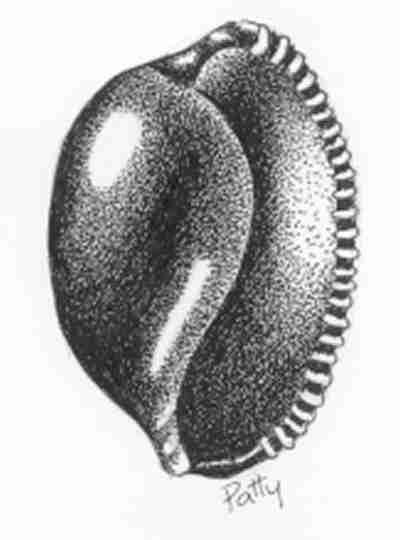
Chimaeria incomparabilis
Courtesy Patty Jansen
Conidae
Pain Killers
Following from Dr Bruce Levitt's seminar, a recent article from the Daily Telegraph (18/8/98) reported that the drug SNX - 111 (Zirconotide) has been produced from
Conus magus .This experimental drug has been successfully used in the treatment of pain in patients with terminal cancer, shingles, AIDS and the phantom pain of amputees.
The head of the pain centre at Royal North Shore Hospital, Professor Michael Cousins is planning to trial the drug during dental extractions and hopes that it will help alleviate the "phantom "pain where the tooth has been removed. The drug is a breakthrough in pain management as it is not addictive like morphine, has few side effects but is more potent than opiate type drugs.
Book Review
By Patty Jansen:
A revision of the Scaphopoda from Australian waters (Mollusca)
By Kevin L. Lamprell and John M. Healy, June 1998
Records of the Australian Museum, Supplement 24: 1-189
The scaphopods, or tusk shells, are well-represented in the Australian
molluscan fauna, especially in northern Australia. However, up till now it has been virtually impossible to identify many of these species, because any literature was scarce, more than 40 years old, and concentrated on southern Australian species.
Enter this long-awaited volume. Kevin and John have spent years working on
this volume, examining the scaphopod collections from Australian and
overseas institutions and all type specimens.
This work for the first time describes and reviews the entire Australian
scaphopod fauna. A total of 108 species belonging to both scaphopod
orders, eight families, and 16 genera, are described. The species are
illustrated in black and white photographs, and meticulous black and white line drawings.
The work describes 47 new species, and records many species from Australia for the first time. Many species are photographed for the first time. Also, the parameters of a number of genera were revised according to radular ultrastructure and shell morphology. Many long-standing identification errors are rectified through study of the original type material. For each species an Australian distribution map is provided, but ranges outside
Australia are mentioned.
Kevin Lamprell is a well-known author on the Australian molluscan fauna,
especially bivalves. He has co-authored three books on Australian bivalves, Bivalves of Australia Vol. 1 and the recently published Bivalves of
Australia Vol. 2, and Spondylus, spiny oyster shells of the world. He has
also co-authored many scientific publications describing new species.
John Healy is a senior research fellow at the University of Queensland. He
has been working with Kevin for a number of years, and has co-authored many publications describing new species of bivalves or scaphopods. He is known for his scientific work on the taxonomic importance of molluscan spermatozoa.
Scaphopods is going to be a volume of importance for all general collectors
of Australian and Indo-Pacific shells. Although published in a rather
scientific journal, it is really very useful for collectors. Even the fact that the pictures are not in colour does not make too much difference. I
wonder how much colour photos would have added in appeal of this work: most of the shells are white anyway! One of the drawbacks might be that all shells look the same in the photos. Unfortunately, Scaphopods do have a tendency to look alike, and when the authors had just embarked on this project, I heard Kevin utter many words of regret he ever started it in the first place. But they have devised a great way of identifying the
Scaphopods by looking at their cross-sections at the top and bottom. These
features are illustrated in line drawings, and add much to the value of this work and set a standard for identifying Scaphopods worldwide.
Open the bottom drawers of your shell cabinet and start identifying your
Scaphopods!
Microshells
Patty Jansen has established a great web site about Microshells, focussing on Australian Microshells. It includes Pictures, drawings, descriptions, links and other useful information. The web site Homepage is located at: www.ozemail.com.au/~filejest
The Australian Microshell Homepage
now includes a reasonably complete listing of the Australian Scissurellidae.
Comments are invited, especially those of a taxonomic nature.
The sheller editor has included examples taken verbatim from Patty's web pages to wet your appetite, as follows:
Firstly is the most important web page to get you started,
How to collect Microshells:
"Collecting microshells is easy, it doesn't get you tired or dirty, doesn't necessarily occupy a lot of time, doesn't cost much, and on top of all that - it is quite easy to instruct somebody else to do it for you.
All you need is a plastic bag, or some other form of container. You find a deposit of shell grit on the beach and scoop a couple of hand fulls of shell grit in the bag. Pronto! Finished!
Oh, well, I did say something about finding the deposit of shell grit. That can be a little difficult. If there is any shell grit at all, you will usually find it in the mid to high tide level on the sandy beach, or right at the point where there is a gradient change in the beach slope. The beaches that are most likely to have a good deposit of shell grit are usually those that are not exposed to the full force of the waves. The shell grit can be found washed up next to either end of a beach between rocky headlands, or all along the high tide line. If there are mangroves it may pay to wonder over to where they are; their roots often trap small material which washed up on the beach behind them. If there is a creek entrance, that is the first place I would be heading; you often find excellent shell grit on either side of a creek or river mouth, especially after rain.
It is a good idea to wash your shell grit when you come home; salt crystals can damage your shells over the years. I usually put the grit in an old cloth nappy, tie up the corners and dunk it into a bucket of water. I then go into the garden and swing the bundle until it doesn't drip any more. I tip the contents onto an old newspaper and leave them for at least a couple of days.
I have an assortment of kitchen sieves and splatter screens (all from the department store kitchen department) to separate the grit into manageable portions of various sized particles. I separate as much sand and rubbish from the shell grit as my sieves will allow me to. This will vary with the source of the shell grit and the types of shells I am hoping to get (some can be awfully small).
Next comes the hard bit - you really need a microscope to sort through shell grit. A low-power, binocular dissecting microscope' is ideal. The magnification should be in the range 5X to 60X at the most. Funnily enough, these microscopes are more expensive than their more powerful counterparts, but can sometimes be picked up second hand through Universities. If you wish to buy a new one, look in the lab supplies' section of the yellow pages, and shop around. Make sure you know what you want, but as with all things, you usually get what you pay for. You don't need an expensive light source for sorting microshells (although this type of light can be very, very useful if you ever wanted to photograph your beauties); an ordinary desk light will do."
Secondly are three examples of how the shells are presented in the web pages:

Dentimitrella tayloriana Reeve, 1859
The shell is high-spired; the sides of the spire are slightly convex. The whorls are flat and smooth; the sutures are visible, but barely impressed. The shell surface is smooth and polished, covered in a thin periostracum. The outer lip is sharp and dentate within. The colour consists of patterns of brown on a white background. A row of sharply defined brown circles just below the sutures is characteristic for this species.
Size: 11mm.
Range: Central New South Wales to Victoria, including Tasmania.
Remarks: This is one of the most common species of Columbellidae on Sydney's beaches.
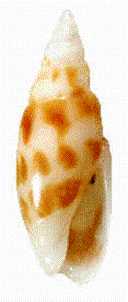
Belloliva triticea Duclos, 1835
The shell is narrow and high-spired. The whorls are slightly rounded. The shell surface is completely smooth. The colour is very characteristic: three rows of brown spots encircle the last whorl on a white background. Sometimes there is a black encircling line between the second and the third row of spots.
Size: 9mm.
Range: Central New South Wales to southern Western Australia, including Tasmania.
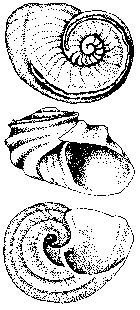
Sinezona carinata (A. Adams, 1862 (non Watson, 1886))
Diagnosis: A medium-sized shell, rather thin. The sculpture consists of three to four strong spiral keels below the selenizone. There is a distinct concave zone below the selenizone. Crossing these keels is fine axial sculpture, which is usually more prominent on the base. The area above the selenizone does not have spiral sculpture, only irregular axial ribs.
Range: NT to Bunbury, WA; New Hebrides; intertidal to 286 m. Also from New Hebrides, Pleistocene
Size: 2 mm
Remarks: The relationship between this species and S. atkinsoni is unclear. The two species appear closely related.
S. carinata tends to have stronger spiral and axial sculpture and the concave zone below the selenizone is more prominent. The two also have distinct ranges.
The Bailey-Matthews Shell Museum
Another web related article. The Bailey-Matthews Shell Museum is a high profile new shell museum (in USA) that has had lots of support and involvement from the shell-collecting community over the last few years. It has a
web site with a photo virtual tour of some of its exhibits.
The site is located at:
www.uwp.edu/academic/biology/bmsm/bm_shell.htm

The above picture is part of the photo virtual tour of the exhibits. It was taken from the web pages in the section on the "Kingdom of the Land shells"
The Mollusc Fauna of Bottle and Glass Rocks and surrounding areas.
(Sydney Harbour)
151 16' 5" E , 33 50' 55" S
By Michael Keats
Ranking among the many great mollusc environments of Sydney Harbour, Bottle and Glass Rocks provides a breathtaking diversity of habitats, water depths and physical conditions which challenge the array of conditions on tropical islands.
The revised species list included in this article covers an expanded sampling area of nearly half a square kilometre. This is mainly due to the efforts of NSW Branch members, Ashley Miskelly and Ernie Uhle. With scuba they have been able to explore the micro environments down to 18m.
We now know that there are underwater rock walls, sea caves, weed beds, kelp forests, grit areas, sand patches plus a range of artificial habitats from human discards.
The range of species being found continues to grow and impress. One of the hardest decisions in writing this article now is to know whether it is the time to stop or to wait for yet more discoveries.
It was only in June this year that two magnificent live specimens of Bursa bufo
were discovered. Turbo exquisita is now being found in numbers and with incredible colour variations. On 11th July came news of more discoveries.
Ericusa sowerbyi fresh dead and Morula echinata alive at 11 metres. When do you stop?
The number of "tropical" species in the list continues to expand. Strombus vomer is an example.
Allied with the mollusc fauna is an amazing Echinoid fauna - more than 30 species to date and more discoveries being made.
Give two hundred years plus of human impact Sydney Harbour still has an incredible diverse biota. We should all be donning scuba so that the discovery process can give us a real data base of the shell fauna.
Peter Morison, the Environmental Officer at Woollahra Council has an indirect interest in Sponges. He reports the existence of many unusual species in the area from Bottle and Glass Rocks to Camp Cove.
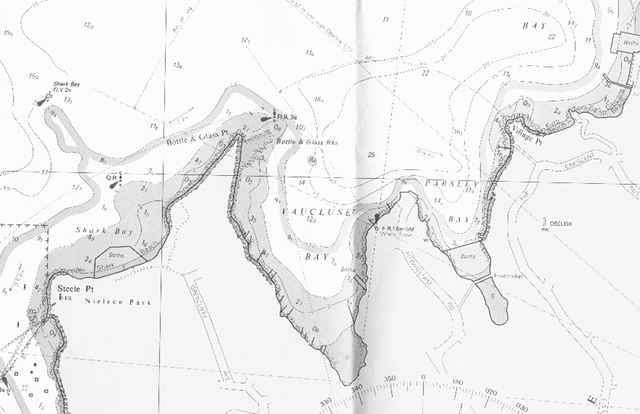
List of the Mollusc Fauna at Bottle and Glass Rocks, Sydney Harbour covering the period December 1996 to July 1998.
The Gastropods
Patellidae
Cellana tramoserica (Holten, 1802) Alive on intertidal rocks
Patella chapmani Tenison Woods, 1876
Patella peroni Blainville, 1825
Lottiidae
Patelloida alticostata (Angas, 1865)
Patelloida mufria (Hedley, 1915
Patelloida latistrigata (Angas, 1865)
Patelloida insignis (Menke, 1843)
Neritidae
Nerita atramentosa Reeve, 1855 Common on intertidal rocks
Nerita albicilla Linnaeus, 1758
Smaragdia souverbiana (Gassies, 1861) Dead in grit
Smaragdia tragena (Iredale, 1936) dead in grit
Haliotidae
Haliotis brazieri Angas, 1859 Live under small rocks 14.8m
Haliotis hargravesi Cox, 1869 Dead in shell rubble 13m
Haliotis rubra Leach, 1814
Haliotis coccoradiata Reeve, 1846
Fissurellidae
Amblychilepas nigrita (Sowerby, 1822)
Montfortula rugosa (Quoy & Gaimard, 1834) Live on rocks
Notomella candida (A. Adams, 1851)
Scutus antipodes Montfort, 1810 Common under intertidal rocks
Tugali parmophoidea (Quoy & Gaimard, 1834) 37mm
Diodora lineata (Sowerby, 1835) Alive under intertidal rocks
Liotiidae
Austroliotia botanica (Hedley, 1915)
Turbinidae
Australium tentoriforme (Jonas, 1845)commom
Australium squamiferum (Koch, 1844)
Ninella torquata (Gmelin, 1791) Not found alive
Subninella undulata (Lightfoot, 1786)
Turbo exquisitus Angas, 1877Fresh dead specimens many colours 30mm 9.8 - 13.5 m dead amongst coarse shell grit / under small rocks Shells always inhabitated by hertmit crabs
Turbo imperialis Gmelin, 1791 Alive in quantity
Phasianellidae
Tricolia variabilis Pease, 1861
Trochidae
Eucheleus aspersus (Philippi, 1846)
Granata imbricata (Lamarck, 1822)
Clanculus brunneus A. Adams, 1853
Clanculus clangulus (Wood, 1828)
Clanculus floridus (Philippi, 1848)
Clanculus maugeri (Wood, 1828)
Clanculus plebejus (Philippi, 1851)
Austrocochlea constricta (Lamarck,1822)
Cantharidella picturata (A. Adams & Angas, 1864)
Eurytrochus strangei (A. Adams, 1853)
Notogibbula bicarinata (A. Adams, 1854) Dead on shell grit 3m
Phasianotrochus eximius (Perry, 1811)
Odonotrochus indistinctus (Wood, 1828)
Gena impetusa (Burrows, 1815)
Astelena scitula (A. Adams, 1855)
Ethminolia probabilis Iredale, 1924
Talopena gloriola Iredale, 1929
Bankivia fasciata (Menke, 1830)
Leiopyrga lineolaris (Gould, 1861)
Monilea callifera (Lamarck, 1822) dead on shell rubble, 10m
Skeneidae
Cirsonella weldi Tenison Woods, 1877
Crossea cocinna (Angas, 1868)
Litiopidae
Alaba opinosa (Iredale, 1936)
Cerithiidae
Bittium granarium (Kiener, 1842)
Velacumantis australis Quoy & Gaimard, 1834
Zeacumantis subcarinatus (Sowerby, 1855) Common in supra tidal pools
Planaxidae
Hinea braziliana (lamarck, 1822)
Turritellidae
Gazameda gunni (Reeve, 1849)
Maoricolpus roseus (Quoy & Gaimard, 1834) Live specimens found of this NZ import on shell rubble 10m
Siliquariidae
Pyxipoma weldi Tenison Woods, 1875
Siliquaria ponderosa Morch, 1860 Dead 90mm
Littorinidae
Bembicium auratum (Quoy & Gaimard, 1834)
Bembicium nanum (Lamarck, 1822)
Nodilittorina unifasciata Gray, 1826
Anabathridae
Pisinna albizona (Laseron, 1950)
Rissoidae
Rissoina angasi Pease, 1872
Rissoina crassa Angas, 1871
Iravadiidae
Nozeba topaziaca (Hedley, 1908)
Vitrinellidae
Callomphala lucida Angas, 1864
Caecidae
Caecum amputatum Hedley, 1893
Struthiolariidae
Tylospira scutula (Leach, 1814)
Strombidae
Strombus mutabilis Swainson,1821
Strombus luhuanus Linnaeus, 1758 Significant colony
Strombus vomer Roding, 1798 One specimen good condition dead at base of boulder 10m
Hipponicidae
Antisabia foliacea (Quoy & Gaimard,1834)
Vanikoridae
Vanikoro orbignyana Recluz, 1843
Calyptraeidae
Crepidula aculeata (Gmelim, 1795)
Sigapatella calyptraeformis (Lamarck,1822)
Chelia flindersi Cotton, 1935 One specimen 25 mm .One live specimen 10m on an old bottle
Cypraeidae
Cypraea caputserpentis Linnaeus, 1758 live
Cypraea erosa Linnaeus, 1758 fresh dead
Cypraea labrolineata Gaskoin, 1848 Live 12 mm
Cypraea vitellus Linnaeus, 1758 Live 56 mm live in cave 3m
Cypraea flaveola Linnaeus, 1758
Cypraea cernica Sowerby, 1870
Cypraea xanthadon Sowerby,1822 live
Cypraea subviridis Reeve, 1835 Fresh dead with bore hole on shell grit 12m
Cypraea clandestina Linnaeus, 1758 live
Cypraea fimbriata Gmelin, 1791live under rock 12m
Cypraea carneola Linnaeus, 1758 dead on boulder 2m
Triviidae
Ellatrivia merces Iredale, 1924
Eratoiidae
Proterato lachryma (Sowerby, 1832)
Naticidae
Natica pseustes Watson, 1887
Taenea saggitata (Menke, 1843)
Polinices melastomus (Swainson, 1821)
Neverita didyma (Roding, 1798)
Mammilla simiae Deshayes, 1838
Eunatica linneana (Recluz, 1843)
Bursidae
Bursa bufo (Roding, 1798) Live in fine condition on rock wall 6m
Cassidae
Phalium labiatum (Perry, 1811)
Phalium pyrum Lamarck, 1822
Tonnidae
Tonna variegata (Lamarck, 1822) dead on weed 8m
Ranellidae
Cymatium labiosa Wood, 1828
Ranella australasia (Perry, 1811)
Sassia parkinsonia (Perry, 1811) 37mm
Cabestana spengleri Perry, 1811 Mating pairs observed in quantity in the intertidal zone
Charonia lampas rubicunda (Perry, 1811) live on shell grit 5m
Cymatium exaratum (Reeve, 1844)
Cymatium pathenopeum (von Salis, 1793)
Triphoridae
Hedleytriphora fasciata Tennison Woods, 1879
Triphora sp,
Epitoniidae
Epitonium minora (Iredale, 1936)
Opalia australis Lamarck, 1822 Live 37 mm
Eulimidae
Pictobalcis articulata (Sowerby, 1834)
Muricidae
Chichoreus denudatus (Perry, 1811) 45 mm outstanding specimen dead in shell rubble 3m
Prototyphis angasi (Crosse, 1863) dead in shell rubble 5m
Bediva paivae (Crosse, 1864)
Dicathais orbita (Gmelin, 1791)
Cronia aurantica (Hombron & Jacquinot, 1853) 40 mm
Lepsiella reticulata Blainville, 1832
Morula marginalba (Blainville, 1832)
Agnewia tritoniformis (Blainville, 1832)
Morula echinata (Reeve, 1846) live under rock 11m
Buccinidae
Cominella eburnea Fischer, 1864
Nassaridae
Nassarius nigellus Reeve, 1854
Nassarius burchardi (Dunker in Philippi, 1849)
Nassarius pauperus Gould, 1850
Nassarius particeps (Hedley, 1915)
Fasciolariidae
Fractolatirus normalis Iredale, 1936
Collumbellidae
Pyrene scripta (Lamarck, 1822)
Dentimitrella semiconvexa Lamarck,1822
Dentimitrella lincolnensis Reeve, 1859
Dentimitrella peroniana Hedley, 1913
Aesopus pleurisulcatus Reeve, 1859
Parviterebra brazieri Angas, 1875
Macrozafra succinea Hervier, 1899
Pseudamycla dermestoida (Lamarck,1822)
Volutidae
Voluta magnifica (Gebauer, 1802) Juvenile crabbed
Ericusa sowerbyi (Kiener, 1839) Mature crabbed
Olividae
Alcospira oblonga (Sowerby, 1830)
Alcospira monilifera (Reeve, 1864)
Zemira australis Sowerby, 1841 dead on sand 6m
Olivellidae
Olivella leucozona A. Adams & Angas, 1864
Belloliva exquisita (Angas, 1861)
Marginellidae
Mesoginella infelix (Jousseaume,1875)
Mesoginella sinuata (Laseron, 1948)
Austroginella muscaria (Lamark, 1822)
Mitridae
Mitra carbonaria Swainson, 1822
Mitra badia Reeve, 1845
Mitra cookii Sowerby, 1874
Mitra solida Verco, 1896 fresh dead 7m on shell rubble
Cancilla strangei (Angas, 1867)
Turridae
Epidera hedleyi (Iredale, 1931)
Paradrillia coxi (Angas, 1867)
Paradrillia metcalfei (Angas, 1867)
Etrema bicolor (Angas, 1871)
Austrodrillia angasi (Crosse, 1863)
Tomopleura subtilinea (Hedley, 1922)
Turrid sp
Gemmula diomedea Powell, 1964 30 mm at 15m dead on shell rubble
Conidae
Conus anemone Lamarck, 1810
Conus papilliferus Sowerby 1834
Mangellinae
Euguraleus jacksonensis (Angas, 1867)
Terebridae
Terebra amoena Deshayes, 1859
Duplicaria bernardii (Deshayes, 1857)
Duplicara australis (Smith, 1873)
Architectonicidae
Philippia lutea (Lamarck, 1822)
Pyramidellidae
Syrnola manifesta Hedley, 1912
Chemnitzia hofmani Angas, 1867
Acteonidae
Pupa fumata (Reeve, 1865)
Pupua nivea (Angas, 1871)
Ringiculidae
Ringicula dolaris Gould, 1850
Scaphandridae
Cylichna arachis (Quoy & Gaimard, 1853)
Acteocina fusiformis (A.Adams, 1854)
Umbraculidae
Umbraculum umbraculum (Lightfoot, 1786)
Bullidae
Bulla quoyi Gray, 1843
Bullinidae
Bullinea lineata (Gray, 1825)
Haminoeidae Haminoea tenera A.Adams, 1850
Siphonaridae
Siphonaria funiculata Reeve, 1856
Siphonaria denticulata Quoy & Gaimard, 1833
The Bivalves
Nuculanidae
Nunculana crassa (Hinds, 1843)
Arcidae
Anadara trapezia (Deshayes, 1840)
Barbatia pistachia (lamarck, 1819)
Mytilidae
Trichomya hirsuta (Lamarck, 1819)
Lanistina impacta (Hermann, 1782)
Mytilis edulis (Lamarck, 1819)
Musculus varicosus (Gould,1861)
Modiolus peronianus Gould, 1850 Pair 6mm
Limidae
Limatula strangei (Sowerby, 1872)
Lima orientalis (A.Adams & Reeve,1850)
Pteriidae
Pinctada margaritifera (Linnaeus, 1758)
Ostreidae
Saccostrea glomerata Gould, 1850
Ostrea angasi Sowerby, 1871
Spondylidae
Spondylus tenellus Reeve, 1856 Magnificent coloured pairs
Pectinidae
Scaeochlamys livida (Lamarck, 1819)
Mimachlamys asperrima (Lamarck, 1819)
Pecten fumatus Reeve, 1852 Fresh dead pairs
Anomidae
Anomia descripta Iredale, 1936
Trigonidae
Neotrigonia lamarckii (Gray, 1838) Fresh dead pairs 25 mm in shell rubble
Neotrigonia strangei (A.Adams, 1854) Fresh dead 28 mm
Lucinidae
Codakia rugifera (Reeve, 1835)
Monilitora ramsayi (Smith, 1855) Pairs
Anadontia ommissa (Iredale, 1930)
Divalucina cumingi Adams & Angas, 1863
Kellidae
Kellia sp
Carditidae
Cardita excavata Deshayes, 1854
Cardidae
Acrosterigma kerslakae Healy & Lamprell,1992
Acrosterigma reeveanun (Dunker,1852)
Acrosterigma cygnorum (Deshayes,1855) Pair 26 mm dead in shell rubble 14m
Fulvia tenuicostata (Lamarck, 1819) Pairs 40mm+
Thraciidae
Thracia modesta Angas, 1867
Laternulidae
Laterna creccina (Reeve, 1860)
Myochamidae
Myadora royana Iredale, 1924
Mactridae
Lutraria rhychanea Jonas, 1844
Solenidae
Solen vaginoides Lamarck, 1818 Pairs
Tellinidae
Tellina deltoidalis Lamarck, 1818
Tellina remies Linnaeus, 1758
Leporimetis spectabilis (Hanley, 1844) Single valves 30mm
Donacidae
Donax deltoides Lamarck, 1818
Psammobidae
Gari truncata (Linnaeus, 1767)
Abra simplex Sowerby, 1867
Veneridae
Antigona persimilis (Iredale, 1930) Several pairs 40 mm dead in shell rubble 13m
Antigonia materna (Iredale, 1929) Live pairs 108 mm
Antigonia chemnitzi (Hanley, 1844)live on shell grit 15m
Antigona lammellaris dead in shell grit 9m
Circe scripta (Linnaeus, 1758) Live 67 mm outstanding live on shell grit 3m
Tawera lagopus (Lamarck, 1818) live on shell grit 6m
Bassina disjecta (Perry, 1811) Pairs 45 mm dead in shell rubble at 15m
Katelysia rhytiphora (Lamy, 1937)
Eumarcia fumigata (Sowerby, 1853)
Irus crenutus (Lamarck, 1818)
Irus cumingii (Deshayes, 1854)
Venerupis anomala (Lamarck, 1818)
Dosina sculpta (Hanley, 1845)
Tapes dosatus (Lamarck, 1818)
Callista kingii (Gray, 1826)
Callista diemensis (Hanley, 1844)
Clementia papyracea (Gray, 1825) Pairs in poor condition
Paphia crassiscula (Lamarck, 1818)
Placamen placidum (Philippi, 1844)
Petricolidae
Petricola divergens (Gmelin, 1791)
Corbulidae
Corbula stolata (Iredale, 1930) Pairs 20 mm
Cleidothaeridae
Cleidothaerus albidus (Lamarck, 1819)
Executive Committee Meeting
NSW Branch of the Malacological Society of Australasia.
The meeting was held on the 22nd August 1998 at the home of Ashley
Miskelly, following the monthly meeting.
Present: Des Beechey, Ashley Miskelly, Steve Dean, Chris Barnes.
David Woodhouse and Karen Wadwell attended as observers.
Presentations at monthly meetings by members:
It was discussed that as a standard, presentations should include some form of visual material eg: overheads and slides.
All committee members were to investigate prices for the acquisition of an overhead projector.
Chris Barnes is to produce a list of members addresses and telephone numbers for publication in the Sydney Sheller to facilitate communication.
Steve is to approach interested parties regarding advertising in the Sheller, with costs to be negotiated.
Ron Moylan is currently investigating the possibility of a field trip to the Solomon Islands in 1999. (Tide times will need to be investigated).
John Dunkerley is to handle the subscription fees for branch membership.
The treasurers report in the minutes is to be minimised, only noting larger expenditures and incomes.
Chris Barnes
Secretary
Puzzle Section
Guess what shells these are. Their names are twins:
No. 1
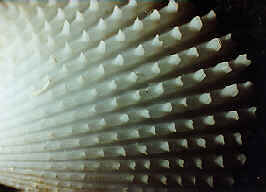
No. 2
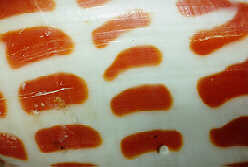
Member News
Nathan Keats, a former junior member, got married this month. Rumour has it that his wife now wants him to take up shell collecting to keep him in check. He hasn't collected since he was nine.
Lady Io Myers and Sir Rupert Myers are currently enjoying holidays at Port Douglas, where Io expects to do some industrious collecting.
Des Beechey is currently studying Columbellidae (Dove shells), specifically the subgenus Dentimitrella. He would like to borrow specimens form anyone who has them. Especially specimens form around Sydney.
Bill Rudman a Resident Scientist in the Malacology section of the Australian Museum, has been in hospital at short notice for a Heart Bypass. We wish him well, and a speedy recovery.
Des Beechey is not at the meeting this month because he is spending the weekend looking for microshells at
Pebbly Beach, NSW south coast.
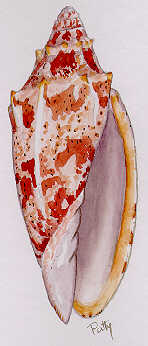
Voluta pulchra cracenta
Puzzle answers:
No. 1 Lima lima
No. 2 Mitra mitra
|









